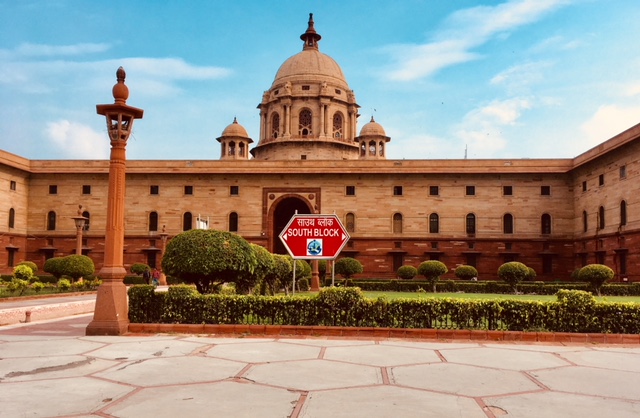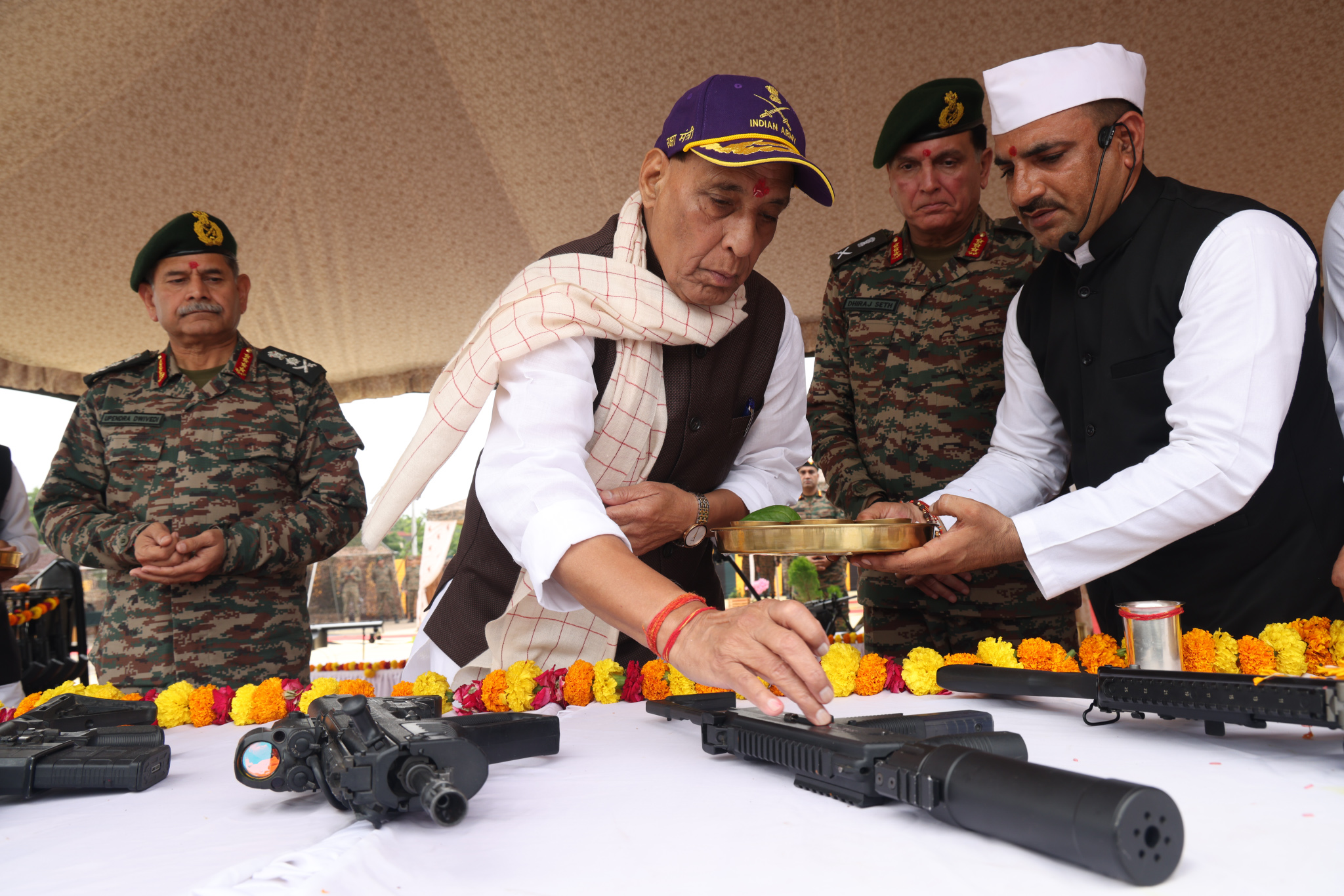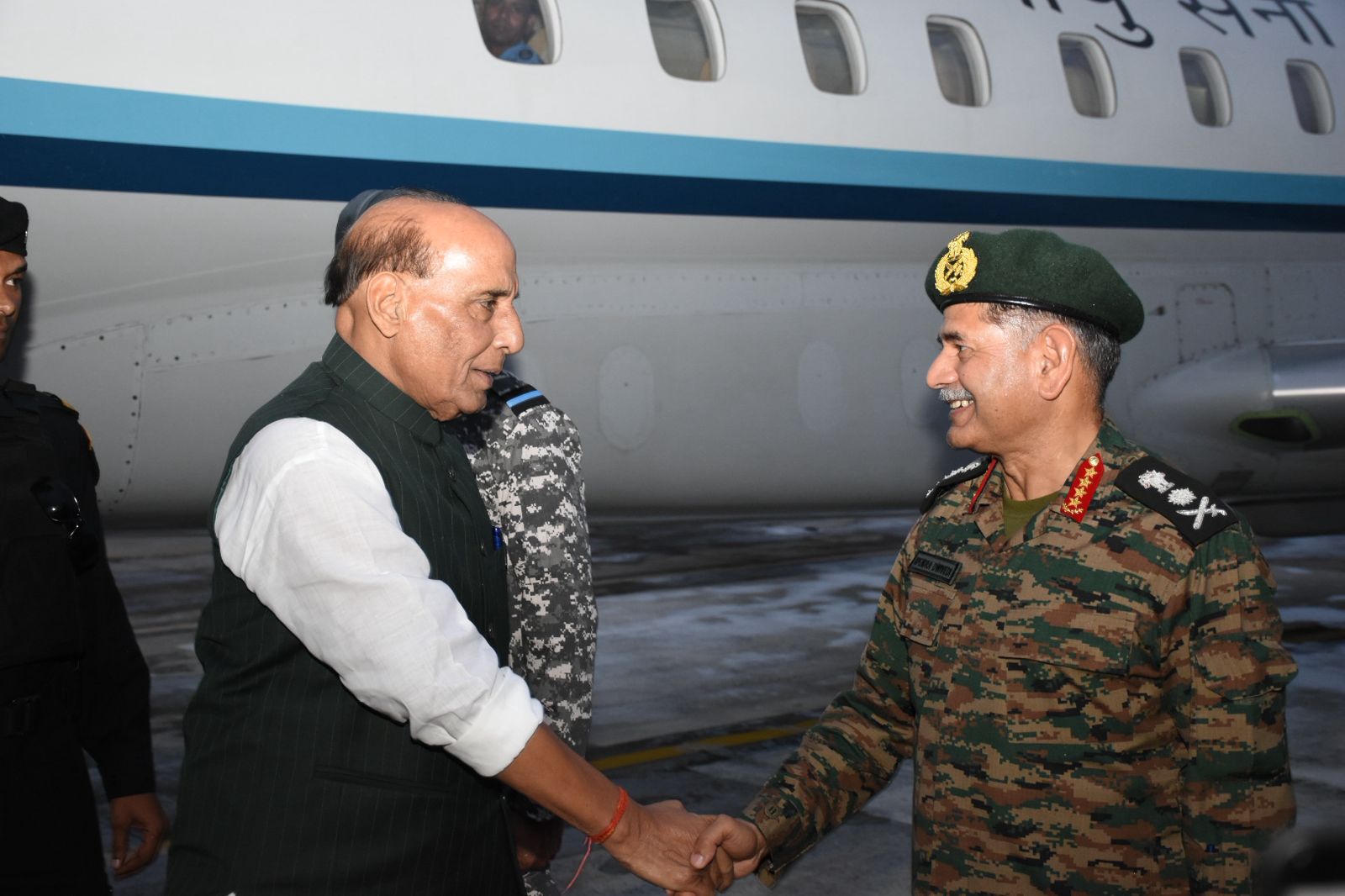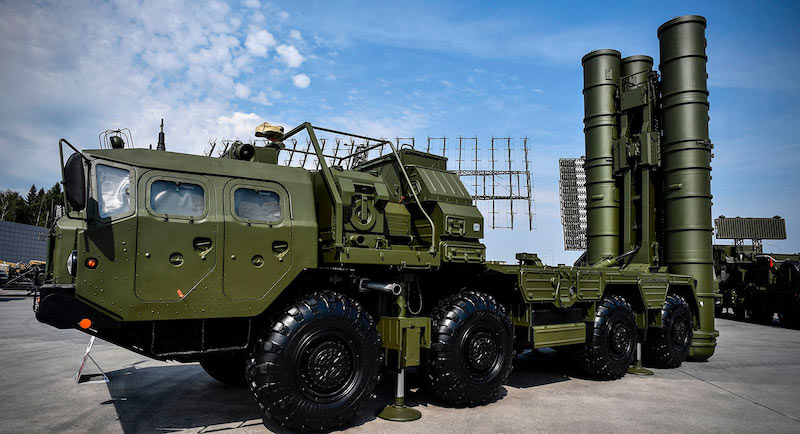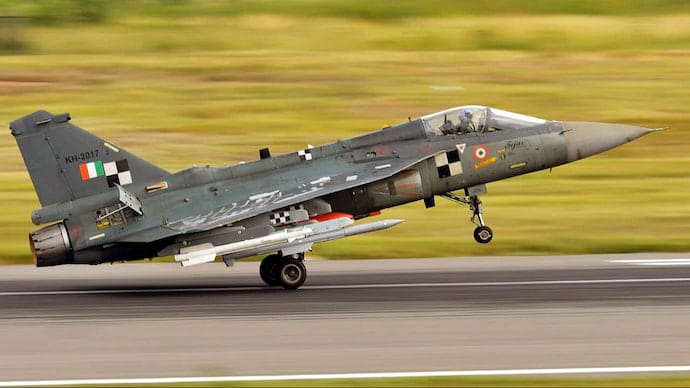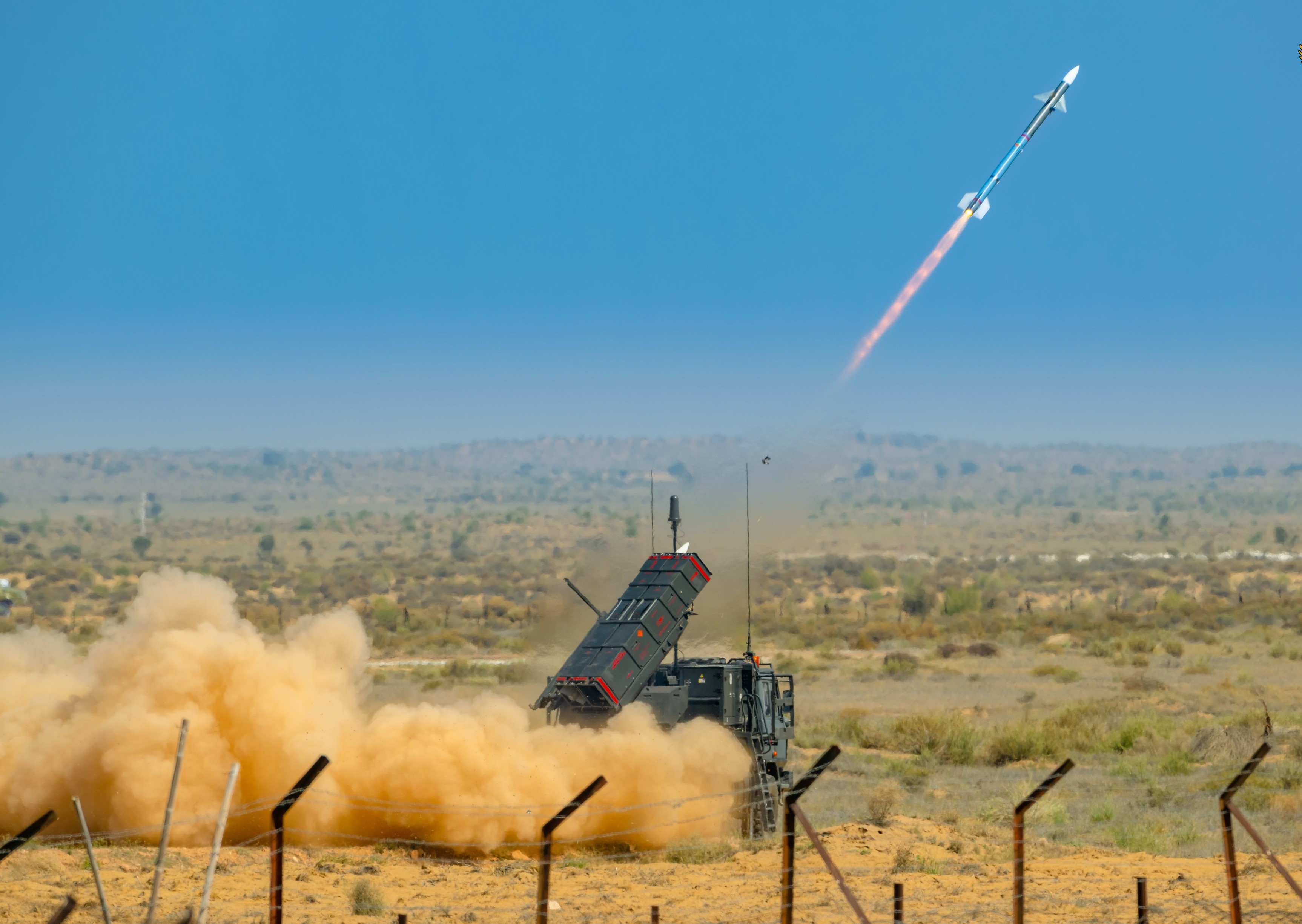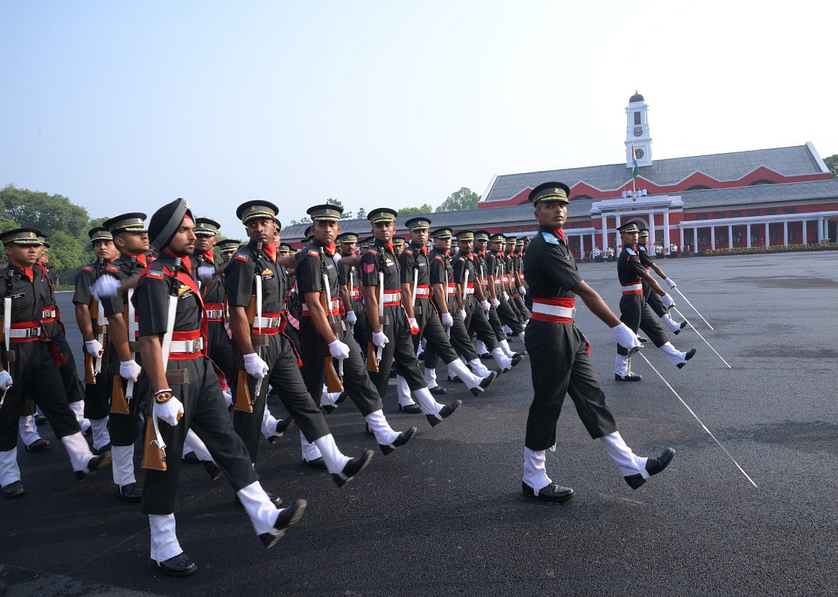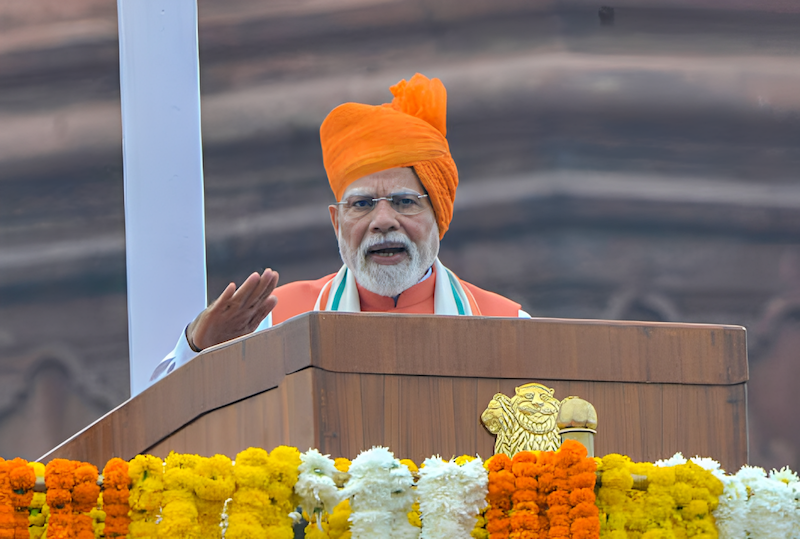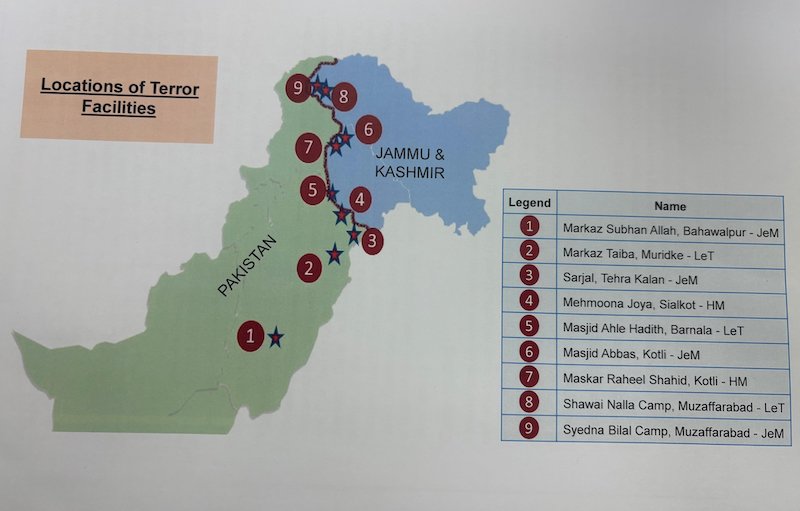 The Indian armed forces released this map marking the sites where they carried out the strikes against terror bases in Pakistan and POK.
The Indian armed forces released this map marking the sites where they carried out the strikes against terror bases in Pakistan and POK.
New Delhi: India conducted precision strikes against multiple terrorist infrastructure targets deep inside Pakistan and Pakistan-occupied Kashmir (POK) in the late hours of Tuesday and early hours of Wednesday, in response to the deadly Pahalgam terror attack of April 22. The military action, codenamed “Operation Sindoor”, targeted nine terrorist facilities from where attacks against India were reportedly planned and directed.
Pakistan has denounced the strikes as an “act of war” and vowed retaliation, raising tensions between the nuclear-armed neighbours to levels not seen since previous confrontations.
The operation came exactly two weeks after the April 22 terror attack in Pahalgam, Kashmir, which claimed the lives of 27 Indian citizens and one Nepali national. All except one of the victims were tourists visiting the popular destination. The lone exception was a local pony-ride operator. Among those dead were an Indian Navy officer, Lieutenant Vinay Narwal, and an Indian Air Force airman, Corporal Tage Hailyang.
As India Sentinels reported earlier on Wednesday, the Ministry of Defence issued an initial statement in the early hours confirming that the Indian military had conducted targeted strikes against terror facilities. The ministry emphasized that a total of nine terrorist sites had been targeted in what it described as “focused, measured and non-escalatory” actions.
The prime minister, Narendra Modi, reportedly monitored the entire operation throughout the night, maintaining direct communication with military commanders as the strikes unfolded. The Indian Army posted a message on X following the successful completion of the operation, simply stating: “Justice is Served. Jai Hind.”
The operation marked India’s most significant military action against Pakistan since the 2019 Balakot airstrikes and demonstrated a decisive response to cross-border terrorism. Unlike previous covert operations, India immediately acknowledged and provided details about the strikes, signalling a shift in its strategic approach to dealing with terrorist threats emanating from Pakistan.
Operation Sindoor was also very different from India’s 2016 surgical strike against POK-based terror camps and the 2019 airstrike against terror camps in Balakot, which is in Pakistan’s Khyber-Pakhtunkhwa province. This time, the multiple strikes covered a range of several hundred kilometres, which included strikes in Bahawalpur and Sialkot in Pakistan’s heartland province of Punjab.
Targets and Execution of Operation Sindoor
According to official Indian statements, nine terrorist facilities were targeted during Operation Sindoor. These strikes focused on specific terror infrastructure across both Pakistan proper and POK, carefully avoiding Pakistani military installations and civilian areas.
The targets included Lashkar-e-Taiba’s base in Muridke near Lahore, Jaish-e-Muhammed’s training camp in Kotli, and Hizbul Mujahideen’s facility in Sialkot. Additional strikes were conducted across the line of control (LoC) in Muzaffarabad, the capital of POK. Indian officials confirmed that targets in Bahawalpur, known for housing terror training facilities, were also hit during the operation.
Indian forces executed the strikes using precision-guided missiles launched from within Indian territory, with no aircraft crossing into Pakistani airspace. This approach minimized the risk of direct military confrontation while achieving the strategic objective of destroying terrorist infrastructure.
Military analysts noted that this demonstrated India’s enhanced strike capabilities and intelligence gathering, which allowed for precision targeting from stand-off distances.
The strikes were carefully timed to occur in the early hours of the morning to minimize potential civilian casualties. Indian officials stressed that the operation was executed with “considerable restraint in selection of targets and method of execution,” focusing exclusively on terrorist facilities with no strikes against Pakistani military installations.
Defence experts believe the operation utilized a combination of BrahMos cruise missiles and other precision-guided munitions to hit the targets with pinpoint accuracy. The Indian Air Force’s air-defence systems were placed on high alert throughout the region to counter any potential Pakistani response.
Pakistan’s Military and Political Response
Pakistani officials reacted swiftly and forcefully to the Indian strikes. The country’s prime minister, Shehbaz Sharif, termed the Indian strikes as an “act of war” and asserted that Pakistan had “every right to give a befitting reply.”
In his statement, Sharif claimed that India had carried out attacks at five locations in Pakistan, though Indian sources reported nine targets.
“Pakistan has every right to give a befitting reply to this act of war imposed by India, and a strong response is indeed being given,” Sharif said in an official statement released hours after the Indian strikes. The prime minister immediately convened a meeting of Pakistan’s National Security Committee to assess the situation and determine an appropriate response.
Lieutenant General Ahmed Sharif Chaudhry, director general of Pakistan’s Inter-Services Public Relations (ISPR), announced that 26 Pakistani citizens had been killed and 46 injured across the six targeted cities. The Pakistani military immediately placed its forces on high alert, with the ISPR claiming that “all planes of the Pakistan Air Force are airborne.”
In what Indian officials described as a disinformation campaign, Pakistan’s ISPR began circulating reports claiming Pakistani forces had conducted retaliatory strikes against multiple targets inside India. These included allegations of missile attacks on 15 locations within India, a strike on the Srinagar airbase by Pakistan’s air force, and the destruction of an Indian Army brigade headquarters.
However, Indian authorities categorically denied these assertions, labelling them as “deliberate disinformation aimed at creating panic and confusion.”
Pakistan’s military establishment also vowed a strong response, with ISPR stating: “Pakistan will respond to it at a time and place of its own choosing. It will not go unanswered. The temporary pleasure of India will be replaced by enduring grief.”
The statement reflected Pakistan’s traditional approach of promising asymmetric responses to Indian military actions.
India’s Official Statements and Briefings
Following the operation, India held a comprehensive briefing led by the foreign secretary, Vikram Misri, flanked by two women officers from the armed forces – Colonel Sofiya Qureshi of the Indian Army and Wing Commander Vyomika Singh of the Indian Air Force. The presence of these officers at the briefing was widely interpreted as a powerful symbolic message, showcasing India’s diverse military leadership, which cuts across religious and gender lines.
In his statement, Misri explained the rationale behind Operation Sindoor. He directly linked it to the April 22 terrorist attack in Pahalgam. The foreign secretary, in his statement, said, “As you are all aware, on April 22, 2025, Pakistani and Pakistan-trained terrorists belonging to the Lashkar-e-Taiba carried out a savage attack in Pahalgam, resulting in the deaths of 25 Indian citizens and one Nepali national.”
Misri then detailed how India had given Pakistan sufficient time to take action against the perpetrators of the Pahalgam attack but had observed no demonstrable steps from Pakistan to dismantle terrorist infrastructure on its territory. “Despite a fortnight having passed since the attacks, there has been no demonstrable step from Pakistan to take action against the terrorist infrastructure on its territory or on territory under its control. Instead, all it has indulged in are denials and allegations,” Misri explained.
He further revealed that intelligence monitoring had indicated that further attacks against India were being planned. “Our intelligence monitoring of Pakistan-based terrorist modules indicated that further attacks against India were impending. There was thus a compulsion both to deter and to pre-empt,” the foreign secretary stated.
Misri emphasized the restrained nature of India’s response, characterizing the actions as “measured, non-escalatory, proportionate, and responsible” that “focused on dismantling the terrorist infrastructure and disabling terrorists likely to be sent across to India.”
Col Qureshi, who is from the Indian Army’s Corps of Signals, provided technical details of the operation, explaining the precision nature of the strikes and confirming that all nine targeted terrorist facilities had been successfully neutralized. She outlined the extensive intelligence gathering that had preceded the operation, ensuring that only legitimate terrorist targets were engaged.
Wg Cdr Singh detailed the air assets involved in the operation, confirming that all strikes were conducted from within Indian airspace and that no aircraft violated Pakistani airspace during the mission.
Pakistan’s Threats and Vows
In response to Operation Sindoor, Pakistani leaders issued a series of statements vowing retaliation against India. Sharif, Pakistan’s prime minister, declared that Pakistan would deliver a “befitting reply” to what he termed an “act of war”. The strong language reflected the Pakistani leadership’s need to project strength to domestic audiences while signalling resolve to international observers.
The Pakistani military, through ISPR, promised that India’s actions “will not go unanswered,” stating that “Pakistan will respond to it at a time and place of its own choosing.” As mentioned before, this language is consistent with Pakistan’s established pattern of responding to Indian military actions through asymmetric means, often involving terrorist proxies or limited military engagement along the LoC.
Lt Gen Chaudhry’s statement, including the ominous warning that “the temporary pleasure of India will be replaced by enduring grief,” also suggested that Pakistan’s response would be calculated to inflict significant damage while potentially avoiding direct attribution.
Pakistani leaders also sought to internationalize the crisis, with the country’s foreign minister, Ishaq Dar, calling for emergency meetings of the Organization of Islamic Cooperation and the United Nations security council to condemn what Pakistan described as “unprovoked Indian aggression.”
However, initial international reactions remained measured, with most countries calling for restraint from both sides while acknowledging India’s stated counterterrorism objectives.
Military analysts noted that Pakistan faces a complex strategic calculation in determining its response. A direct military confrontation with India would risk significant escalation between nuclear-armed neighbours, while a muted response would risk domestic political backlash. This dilemma has historically led Pakistan to pursue deniable, asymmetric responses through proxy actors.
Damage Assessment and Casualties
The full extent of damage from Operation Sindoor and subsequent cross-border exchanges remains difficult to verify independently, with both sides presenting conflicting accounts.
According to Pakistan’s DG ISPR, the Indian strikes resulted in 26 Pakistani casualties and 46 injuries across six cities. Pakistani authorities claimed that several of the casualties were civilians, though they provided no independent verification of this assertion.
Indian officials maintained that their precision strikes targeted only terrorist infrastructure and avoided civilian areas. The MoD statement emphasized that “no Pakistani military facilities have been targeted” and that India had “demonstrated considerable restraint in selection of targets and method of execution.”
Indian sources reported that all nine targeted terrorist facilities were “completely destroyed” during the operation. Satellite imagery released by Indian authorities showed precision strikes against compounds identified as terrorist training facilities, with minimal collateral damage to surrounding areas.
In terms of Indian casualties, officials acknowledged that eight Indians were killed in retaliatory cross-border shelling by Pakistani forces across the LoC. These casualties reportedly occurred when Pakistani forces resorted to artillery firing following the Indian operation.
The Press Information Bureau (PIB) issued fact-checks refuting several Pakistani claims, particularly the assertion that Pakistan had shot down an Indian Rafale fighter jet during the operation.
Economic impacts were immediately felt in both countries, with stock markets in Mumbai and Karachi experiencing significant volatility. The Pakistani rupee fell sharply against major currencies, while international travel advisories were updated to warn against non-essential travel to regions near the India-Pakistan border.
What Lies Ahead?
The execution of Operation Sindoor marks a major shift in India’s counterterrorism strategy. It signals New Delhi’s willingness to conduct overt military operations against terrorist infrastructure, even if they are deep inside Pakistan or Pakistan-controlled territories. This approach differs from past practices of covert operations or limited strikes and establishes a new threshold for India’s response to cross-border terrorism.
Military analysts expect Pakistan to calibrate its response carefully to avoid full-scale conflict while satisfying domestic demands for retaliation. This is likely to involve increased ceasefire violations along the LoC, potential limited strikes against Indian military positions, and possibly deniable terrorist actions through proxy groups in the coming weeks or months.
International diplomatic efforts to de-escalate tensions are expected to intensify, with the United States, China, and Russia likely to engage both countries through diplomatic channels. The United Nations secretary general, António Guterres, has already called for “maximum restraint” from both nuclear-armed neighbours, As India Sentinels had reported earlier.
For India, the operation represents an implementation of its stated policy of holding Pakistan accountable for terrorist attacks originating from its territory. The Modi government has consistently messaged that India reserves the right to respond to cross-border terrorism at a time and place of its choosing – a position now demonstrated and firmly established through Operation Sindoor.
Security measures across India, particularly in major cities and along the western border, have been significantly enhanced in anticipation of potential retaliatory actions. Forces along the LoC remain on high alert, with additional troops deployed to sensitive sectors.
The economic implications of the crisis are also significant, with foreign investors closely watching developments. Extended tensions would likely impact trade, investment, and economic growth in both countries, adding economic pressure to the already complex security calculations.
Perhaps most significantly, Operation Sindoor establishes a new strategic reality in South Asia – one where India demonstrates both the capability and will to strike terrorist infrastructure deep inside Pakistan when provoked by cross-border terrorism.
Geopolitical experts say this recalibration of deterrence dynamics may influence Pakistan’s cost-benefit analysis regarding its historical support for non-state armed groups operating against India. They also largely agree that the coming days will be crucial in determining whether Operation Sindoor marks the beginning of a new, more dangerous phase in India-Pakistan relations or ultimately leads to a reconsideration of Pakistan's approach to cross-border terrorism.


